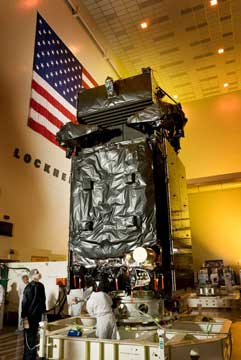
GEO-1 launch set for Friday, May 6 for the U.S. Air Force. The launch window is 2:14 until 2:54 p.m. EDT. The weather forecast is looking very favorable with an 80 percent chance of acceptable weather!
SBIRS, considered one of the nation’s highest priority space programs, is designed to provide global, persistent, infrared surveillance capabilities to meet 21st century demands in four national security mission areas:
- Missile Warning
- SBIRS will provide reliable, unambiguous, timely and accurate warning for theater and strategic missile launches to the President of the United States, the Secretary of Defense, Combatant Commanders, and other users.
- Missile Defense
- The system will deliver critical information supporting the effective operation of missile defense systems against national and theater threats.
- Technical Intelligence
- SBIRS will provide the ability to characterize infrared (IR) event signatures, phenomenology, and threat performance data for strategic and operational combatant commanders, the intelligence community, and others.
- Battlespace Awareness
- The SBIRS constellation will deliver comprehensive infrared data to Combatant Commanders, Joint Task Force Commanders and other users to help characterize battlespace conditions supporting force protection, strike planning and other missions.

The SBIRS team is led by the Infrared Space Systems Directorate at the U.S. Air Force Space and Missile Systems Center. Lockheed Martin is the SBIRS prime contractor, with Northrop Grumman, as the payload integrator. Air Force Space Command operates the SBIRS system.
Lockheed Martin's original SBIRS contract includes HEO payloads, two geosynchronous orbit (GEO) satellites, as well as ground-based assets to receive and process the infrared data. The team is also under a follow-on production contract to deliver additional HEO payloads, the third and fourth GEO satellites, and associated ground modifications.
The Atlas V family of Evolved Expendable Launch Vehicles (EELV) represents ULA's commitment to enhanced competitive launch services for the U.S. government. Since their debut in August 2002, Atlas V vehicles have achieved 100 percent mission success in launches from Space Launch Complex-41 at Cape Canaveral Air Force Station, Florida and Space Launch Complex-3E at Vandenberg Air Force Base, California. Built modularly with flight-proven elements, Atlas V has followed a carefully executed program of incremental improvements resulting in 100 percent mission success. Providing our customers maximum flexibility, capability and reliability has been the foundation of the Atlas program, which has logged nearly 600 launches to date.
The Atlas V family, which includes the flight-proven Atlas V 400 and 500 series are the latest evolutionary versions of the Atlas launch system. Atlas V uses a standard common core booster™ (CCB), up to five strap-on solid rocket boosters (SRB), a Centaur in either the Single-Engine Centaur (SEC) or the Dual-Engine Centaur (DEC) configuration, and one of several payload fairings (PLF). A three-digit (XYZ) naming convention was developed for the Atlas V 400 and 500 series.

